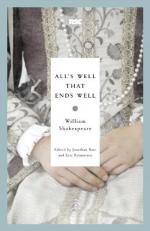|
This section contains 6,261 words (approx. 21 pages at 300 words per page) |

|
SOURCE: "All's Well That Ends Well: A 'Feminist' Play?" in Myriad-minded Shakespeare: Essays, Chiefly on the Tragedies and Problem Comedies, Macmillan Press, 1989, pp. 130-46.
In the following essay, Honigmann considers All's Well That Ends Well as a play that examines the consequences of female dominance, and studies Helena as an aggressive female character.
Shakespeare is sometimes blamed because he expected woman to be beautiful and biddable in a male-dominated world. How unreasonable of him! His heroines, we are told, perpetuate the male myth of woman, as sanctified by the Bible and the marriage-vows of the Church of England; in so far as his feminine ideal was imprinted upon the consciousness of Europe, and later of the world, he was at least as guilty of the enslavement of woman as St Paul, who wrote that 'the husband is the head of the wife, even as Christ is the head...
|
This section contains 6,261 words (approx. 21 pages at 300 words per page) |

|


